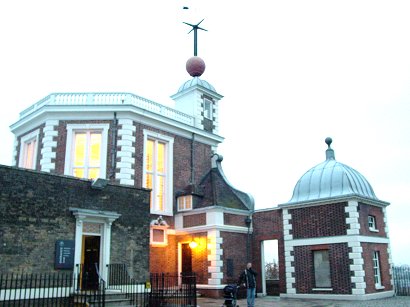
Greenwich
A few miles downstream from London, Greenwich has always been connected with sea travel in some way, early on because it was a fishing village. Upon the conclusion of the Wars of the Roses, Henry VII created a revolutionary palace there named Placentia. Unlike most palaces of the time it was completely devoid of fortification. Perhaps because the palace was popular with Henry VIII, royal dockyards were constructed to the east and west of Greenwich at Woolwich and Deptford where he could keep close tabs on naval matters.
Starting in 1616 Queen Anne of Denmark, the wife of James I, had another palace built, this time a small one designed by Inigo Jones - the Queen's House. The new palace was also revolutionary - Jones made significant use of geometry and mathematics in its design. Although Anne didn't live to see the palace completed, after it was completed in 1635 it was often used for greeting foreign dignitaries just arriving in the country. The Placentia palace declined during the Civil War and Commonwealth, and upon the Restoration Charles II had it demolished and planned a vast new palace to rival Versailles. The money just wasn't there, and the project was abandoned.
Charles had also been considering a hospital for invalid sailors. The idea wasn't acted upon until the reign of William and Mary. Mary had promoted the concept of a magnificent hospital, and when she died William started the project in her honor. Money was raised from a variety of sources including donations, contributions from sailors' pay, and even the confiscated properties of Captain Kidd and a Jacobite nobleman. Construction of the grand and expensive complex was finally completed in 1751.

Royal Observatory
Charles did start the Royal Observatory for the purpose of finding a solution through astronomy of the longitude problem which hindered sea navigation. The building was designed by Christopher Wren on the foundations of Duke Humphrey's Tower, the remains of a medieval castle. The first astronomer royal, John Flamsteed, shared data with Isaac Newton, and was succeeded by Edmund Halley. The longitude problem was eventually solved by better clocks, and Greenwich became the location of the prime meridian and the definitive source for the correct time. The ball on top of the building was lowered at 1pm to indicate the correct time as determined by astronomical observation at noon.

Queens House
The Queen's House is in the center. The original plans for the hospital envisioned demolishing the house and constructing another building here, but fortunately the building was saved. The buildings on either side were built in the 19th century, and along with the Queen's House were the Royal Hospital School until 1933. The building on the right now houses the National Maritime Museum, and the Queen's House now holds what is probably the most impressive collection of naval art in the world.

Royal Naval Hospital
This is the view from the best possible vantage point of the hospital, right at the river gate. The British took pride that their invalid sailors were housed in such a grand palace, but the hospital closed in 1865. The Royal Naval College occupied the buildings from 1873 to 1997 when Greenwich University took them over. A music school also uses the site.

From North Side of Thames
A pedestrian tunnel was constructed under the Thames in 1902. It is still in operation with an elevator is on each end attended by someone who is annoyed that people don't seem to see that they have to push a button for service. This is the view from the north side of the river. You can see the masts of the 19th century clipper ship Cutty Sark on the right then the cupola for the tunnel.